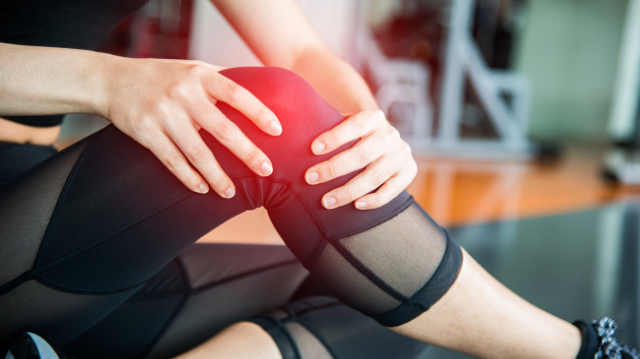
The knee is the next region of the body we’re going to examine, as it ranks up there with the back, neck, and shoulder as a hot spot for musculoskeletal pain. Knee pain is especially common in athletes of sports that involve lots of cutting motions and is the leading cause of disability in older adults. But sports and advanced age are far from the only factors that can increase the risk for knee problems.
The knee is the largest and one of the most complex joints in the body, and its complexity is one of the main reasons it’s so vulnerable to injury. The frequency with which it’s used also plays a significant role. The knee is a hinge joint that’s responsible for bearing weight and allowing the leg to extend and bend back and forth with minimal side–to–side motion. It primarily joins the thighbone (femur) to the shinbone (tibia), but also includes the kneecap (patella) and other lower leg bone (fibula). The patella is a small, triangle–shaped bone that sits in the front of the knee within the quadriceps muscle, and it’s lined with the thickest layer of cartilage in the body because of the massive forces it takes on.
Knee pain is the leading cause of disability in adults aged 65 years and older—with knee osteoarthritis being responsible in most of these cases—while various tears are more likely to occur in active individuals. Here’s a look at some of the most common conditions that physical therapists treat:
- Knee osteoarthritis: an extremely common disorder in which the cartilage on the ends of bones in the knee gradually wears away, which reduces its ability to absorb shock and increases the chances that bones will contact one another; usually leads to pain, stiffness, and swelling that makes it difficult to walk and move the knees normally
- ACL tear: the anterior cruciate ligament (ACL), which helps stabilize the upper leg bone to the knee, can be damaged or torn when an athlete suddenly cuts or changes direction; ACL tears are most often seen in football, basketball, and soccer, and sideline athletes for extended periods of time
- Meniscus tear: tears of the meniscus, a tough piece of cartilage that absorbs shock and stabilizes the knee, typically occur from twisting or turning too quickly on a bent knee, often when the foot is planted on the ground; degenerative meniscus tears may also occur in older adults; symptoms include pain, swelling, and difficulty extending the knee
- Patellofemoral pain syndrome: sometimes referred to as “runner’s knee,” this overuse injury results from repetitive movement of the kneecap against the thighbone, which can damage the tissue under the patella; as the name suggests, runner’s knee is most common in runners and other athletes
For knee pain that doesn’t improve with at–home exercises, see a physical therapist
If you find yourself dealing with knee pain, either from a traumatic incident or due to sustained damage over time, one of the first steps you can take is to try managing it on your own at home with some targeted exercises. These include stretching exercises like the quadriceps stretch, hamstring stretch, calf stretch, and knee range of motion exercise, and strengthening exercises like the wall sit, bridge exercise, single–leg heel raise, and partial lunge. If these exercises fail to produce notable improvements, the next step is to see a physical therapist, and preferably sooner rather than later.
Physical therapists frequently see patients with all types of knee–related conditions and are adept at creating personalized treatment plans based on the patient’s condition, abilities, and goals. A typical treatment program for knee pain will include the following:
- Strengthening exercises to build back up the weakened muscles of the leg
- Stretching and range of motion exercises to increase flexibility and regain normal mobility
- Plyometrics, or jump training (especially for patients recovering from ACL tears)
- Recommendations on how to modify activities to minimize the risk for future injuries
- Exercises to improve body awareness, balance, and neuromuscular control, which is the body’s ability to stay strong and stable during all movements
- Activity–specific training for athletes and active individuals
Research has shown that physical therapy can significantly improve patient outcomes and help them avoid knee surgery in certain cases. There is an abundance of evidence on physical therapy for meniscus injuries, including a powerful study called a randomized clinical trial, which found that physical therapy led to similar improvements in physical function when compared to surgery for patients with meniscus tears. Furthermore, a follow–up analysis of this trial showed that physical therapy is more cost–effective than surgery for meniscus tears, while a separate review of 6 studies found that although surgery led to some initial advantages over exercise therapy, there were no differences between groups 12 months later. A systematic review and meta–analysis of 14 studies also found that manual therapy, an important component of most knee treatment programs, is likely to be effective and safe for improving pain, stiffness, and physical function in patients with knee osteoarthritis.
In our next post, we’ll look at the injuries and conditions involving the wrist and elbow.
